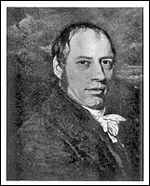Richard Trevithick

Richard Trevithick (13 April 1771 – 22 April 1833) was an English inventor, who was born in Illogan, Cornwall.
Richard Trevithick was the son of a mine engineer, and as a child would watch steam engines pump water out of the deep tin and copper mines which were common in Cornwall.
As an adult, he set about improving upon the design of steam engines, by making smaller and lighter engines with stronger boilers, which would generate higher steam pressures and therefore generate more power.
In 1801, he put one of his new compact steam engines on wheels. This "road locomotive", which became known as the Puffing Devil, was one of the world's first road vehicles to move under its own power and carry passengers (it was preceded by the Nicolas-Joseph Cugnot's "steam wagon"), and was an early forerunner to the car. His road locomotive ran through the streets of Camborne in Cornwall, taking his friends on short trips. However, it lacked the ability to keep up steam pressure for prolonged periods, and so had little practical use.

In 1803 he built another early self propelled road vehicle, the "London Steam Carriage" which was basically a stagecoach fitted with a steam engine. It attracted much attention from the public and press, but it proved more expensive to run than a conventional horse-drawn carriage and so failed to catch on.
The following year, Trevithick built the world's first railway steam locomotive. Trevithick's locomotive had no name and was used at the Pen-y-Darren ironworks near Merthyr Tydfil in Wales, and pulled up to 10 wagons at speeds of around 5 mph (8 km/h). It first ran on 21 February 1804. Although it worked, it was not financially successful as it was too heavy for, and kept breaking the rails (which were designed for horse-drawn trains). Trevithick had also built an earlier experimental locomotive at Coalbrookdale in England but little is known about it.
Trevithick also built steamboats, river dredgers and threshing machines.
Trevithick was a pioneer whose inventions were ahead of their time. Despite publicity stunts such as running a steam locomotive called Catch me who can on a circular track in London, Trevithick found it difficult to persuade investors to fund his locomotive building.

In 1816 Trevithick moved to Peru to work as a mine engineer, and to build locomotives to serve them. Although initially successful, civil war broke out in 1826 and he was eventually forced to return to Britain penniless.
Despite his inventive genius and world first achievements, Trevithick died in poverty and obscurity, with his achievements being largely unrecognised.
